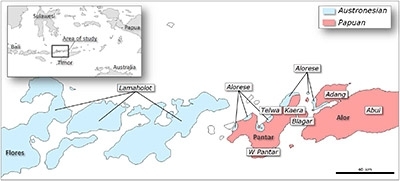Research project
Reconstructing the past through languages of the present: The Lesser Sunda Islands
What can languages spoken in the Lesser Sunda Islands today tell us about the histories of its various population groups?
- Duration
- 2014 - 2019
- Contact
- Marian Klamer
- Funding
-
 NWO VICI
NWO VICI

Project summary
In areas without written historical records, where archaeological and ethnographic data are absent or sparse, language forms the backbone of our understanding of socio-cultural history. This project investigates one such region, in eastern Indonesia. What can languages spoken in the Lesser Sunda Islands today tell us about the histories of its various population groups?
Answering this question requires a novel, productive conjunction of contact linguistics, historical linguistics, and language typology studies. Our methodology includes quantitative cross-validation of qualitative research, and careful control of the variables that is uniquely possible in the Lesser Sundas.
Through synchronic language data, this project traces the socio-cultural history of population groups on Flores, Pantar, and Alor. It combines linguistic tracing of cultural contact and migration (e.g. kinship terminology, place names, ritual language) with three case studies of contact-induced transfer between Papuan and Austronesian languages, involving superstrate, adstrate and substrate influence respectively. Qualitative data, comparisons, and historical scenarios are quantitatively cross-validated. This contrastive comparison of different paths of change at a regional level, with typology as a constant and quantitative validation of qualitative results, truly breaks new ground.
The investigation will show which social circumstances and types of contact lead to which patterns of change. As such, it will refine (probabilistic) constraints on contact-induced transfer, and advance insight into the various changes that occur in contact between typologically different languages. This is of high theoretical and methodological relevance, locally and, notably, elsewhere in the world: it will facilitate the distinction of vertically and horizontally transmitted language features, and expand the scope and reliability of linguistic findings for reconstructing the socio-cultural past.
The Lesser Sundas offer a unique laboratory for this research. The project is urgent, as all the languages in question will soon become extinct, and essential data for linguistic theory and socio-cultural history will disappear.
Project aim
This project studies synchronic language data from the Lamaholot-Pantar-Alor region (see Fig. 1) to investigate (a) the history and dispersal of speakers of Papuan Alor-Pantar languages, and (b) their interactions with Austronesian speakers.
 Figure 1. Languages under investigation in their geographical and genealogical context.
Figure 1. Languages under investigation in their geographical and genealogical context.
The project interweaves three lines of inquiry:
- Chart social networks and reconstruct migration histories of population groups, through the qualitative study of linguistic traces of cultural contact (kinship terms, ritual language) and migration (toponyms) (Project component 1)
- Reconstruct changes and retentions of words and grammatical structures, by investigating three contact settings, all representing Austronesian-Papuan contact but varying in direction of change (Austronesian > Papuan vs. Papuan > Austronesian), intensity, language status (equal/unequal), and time-depth (contemporary/ancient) (Project components 2-3-4). By comparing processes and results in the respective settings, we can reconstruct the circumstances of contact.
- Cross-validate the qualitative results of project components 1-4 through a quantitative study of traces of linguistic history and ancestral culture. (Project component 5)
